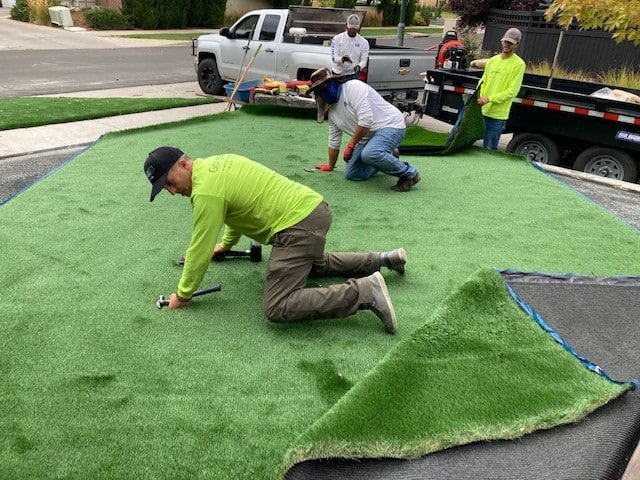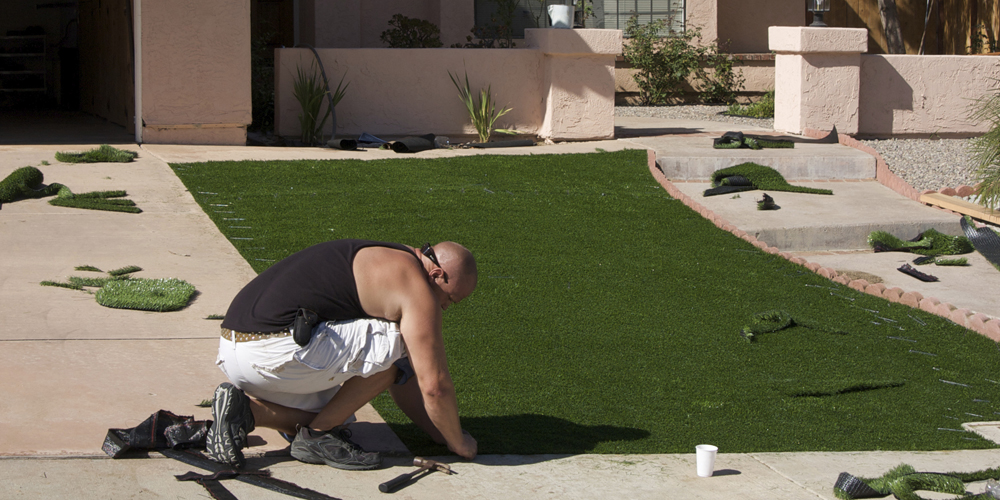Top Reasons to Think About Artificial Lawn for a Low-Maintenance and lush Lawn
As home owners progressively seek sustainable solutions for outside areas, synthetic yard presents an attractive choice to traditional yards. The benefits extend beyond simple aesthetics and sustainability; checking out the complex implications of synthetic lawn discloses a comprehensive technique to backyard monitoring that benefits deeper consideration.
Year-Round Greenery
One of the most significant advantages of artificial grass is its ability to offer year-round greenery, regardless of environment problems. Home owners often face obstacles in keeping a vivid grass as a result of seasonal adjustments, droughts, or heavy rainfall. Fabricated yard gets rid of these worries, making sure a constantly rich appearance throughout the year.
This synthetic alternative is crafted to hold up against varied weather scenarios, from burning summertime warm to freezing wintertime temperature levels. Unlike all-natural yard, which might brownish or come to be patchy throughout extreme conditions, synthetic grass keeps its vivid shade and structure, improving the visual charm of any type of landscape.
Additionally, man-made lawn is resistant to pests and diseases that commonly influence all-natural lawns. This strength adds to its long-lasting appeal, as there is no requirement for chemical treatments or plant foods that can be damaging to the setting. Homeowners can take pleasure in the aesthetic benefits of a well-kept grass without the cyclical difficulties postured by natural turf treatment.
Reduced Maintenance Efforts
Fabricated grass substantially lowers maintenance efforts, enabling home owners to enjoy an excellent grass without the time-consuming tasks linked with natural turf treatment. Among the most significant benefits of synthetic grass is the elimination of routine mowing. Without any need for a lawnmower, home owners save both time and the price of maintenance related to this equipment.

Cleaning man-made lawn is straightforward; a basic rinse with a hose or the occasional cleaning to get rid of debris is normally enough - turf installation. This ease of care permits home owners to spend more time appreciating their exterior rooms as opposed to laboring over them. In summary, the minimized upkeep initiatives associated with synthetic lawn make it an enticing choice for those seeking a stunning, convenient backyard
Water Preservation Benefits
The significant reduction in maintenance efforts connected with man-made lawn expands to water preservation, making it an environmentally friendly option for property owners. Conventional yards call for significant quantities of water to continue to be dynamic and rich, usually bring about too much water use, specifically in dry areas. In comparison, artificial yard removes the need for regular watering, considerably minimizing the general water intake in your backyard.
By going with synthetic lawn, home owners can preserve thousands of gallons of water each year. This change not just benefits individual houses yet likewise contributes to broader ecological efforts targeted at reducing water waste. In locations experiencing water shortage, the adoption of fabricated lawn can play a backyard artificial grass considerable role in alleviating the results of dry spell and making sure that important water sources are used more successfully.
Moreover, the installation of fabricated turf can help reduced municipal water need, benefiting the area overall. With expanding awareness of ecological issues, picking synthetic yard acts as an aggressive step in the direction of sustainable landscape design, assisting to maintain natural water resources while maintaining a cosmetically pleasing outside room (artificial grass installation). In summary, fabricated turf presents an engaging solution for water conservation, straightening environmental obligation with modern-day landscaping demands

Bug and Allergic Reaction Decrease
A significant advantage of mounting artificial grass is its capacity to minimize bugs and irritants in outside areas. Conventional turf lawns typically function as breeding premises for bugs such as mosquitoes, ticks, and ants, which can develop discomfort and wellness dangers for pet dogs and family members. On the other hand, synthetic grass removes the organic material that brings in these insects, thereby significantly decreasing their populations in your backyard.
In addition, natural yard can nurture mold, plant pollen, and other irritants, which can trigger allergic reactions Check This Out and breathing concerns for delicate people. Synthetic lawn supplies a cleaner environment, minimizing the potential for allergenic responses. Unlike natural lawn, synthetic grass does not produce plant pollen, making it an outstanding alternative for allergy victims seeking to appreciate their outdoor areas without the threat of flare-ups.
Furthermore, the lack of soil in man-made lawn implies there is much less dust and dirt, additional minimizing air-borne irritants. This low-maintenance alternative not just boosts the aesthetic charm of your backyard but likewise advertises a healthier outside setting, allowing households to appreciate their lawns without the continuous concern of parasites and allergens. Thus, man-made yard is a tactical option for those focusing on convenience and health in their outdoor home.
Long-Term Price Savings
Buying artificial lawn can bring about substantial lasting price savings for property owners. While the initial investment might seem considerable, the financial benefits with time can be considerable. Synthetic turf gets rid of the requirement for routine yard upkeep costs, such as mowing, feeding, and watering. Standard grass often require substantial resources to maintain a lavish look, specifically in locations susceptible to drought or severe weather.
Moreover, the long life of artificial grass even more enhances its cost-effectiveness. The majority of high-grade fabricated lawn products can last 15 to 25 years with minimal maintenance, minimizing the need for substitute or considerable repair services. On the other hand, all-natural lawn may call for regular reseeding and regular treatment, which can rapidly build up in prices.
Utility savings are an additional vital factor. Home owners can expect to see reduced water expenses, as synthetic grass does not require watering. Furthermore, the decrease in yard treatment services can release up important time and sources, enabling home owners to Visit Website designate their budgets in other places.
Conclusion
In summary, man-made yard presents various advantages for house owners looking for a vivid and low-maintenance landscape. Eventually, the long-lasting expense financial savings linked with fabricated lawn solidify its status as a useful and sustainable service for improving outside areas.
Man-made lawn dramatically lowers upkeep initiatives, enabling house owners to appreciate an immaculate grass without the taxing jobs connected with all-natural turf care.The considerable reduction in maintenance initiatives linked with man-made lawn expands to water preservation, making it an eco pleasant alternative for homeowners. In comparison, artificial yard removes the demand for routine watering, substantially lowering the total water intake in your lawn.
In areas experiencing water deficiency, the fostering of synthetic grass can play a substantial function in reducing the effects of dry spell and making sure that valuable water resources are used a lot more efficiently.
With growing awareness of ecological problems, choosing fabricated turf offers as a positive step in the direction of sustainable landscape design, helping to maintain natural water resources while maintaining a cosmetically pleasing outside room.
 Jake Lloyd Then & Now!
Jake Lloyd Then & Now! Jonathan Taylor Thomas Then & Now!
Jonathan Taylor Thomas Then & Now! Bradley Pierce Then & Now!
Bradley Pierce Then & Now! Talia Balsam Then & Now!
Talia Balsam Then & Now! Nadia Bjorlin Then & Now!
Nadia Bjorlin Then & Now!